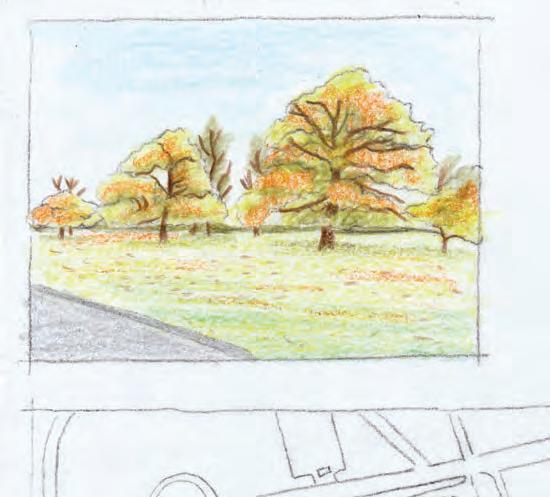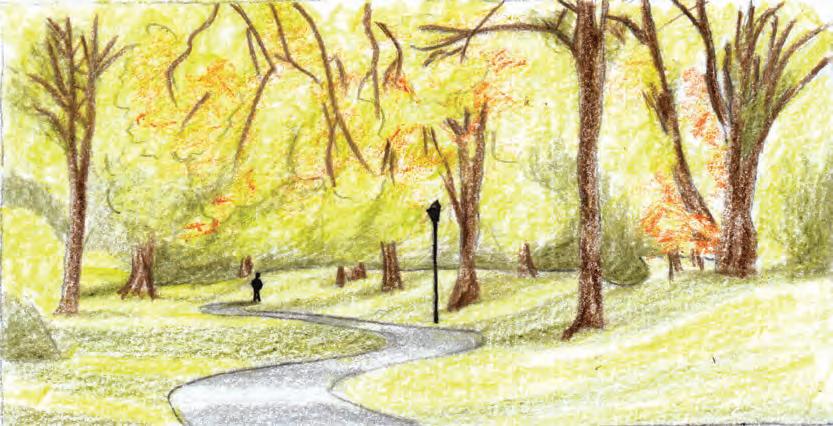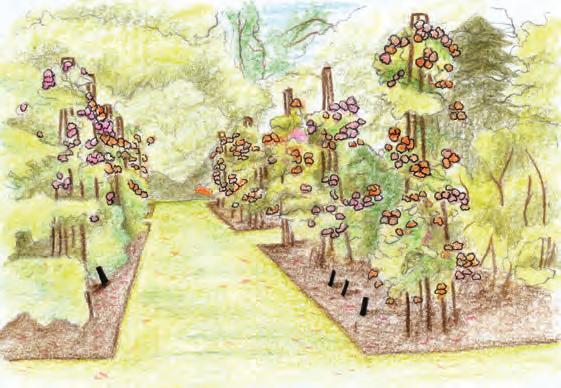
3 minute read
Melbourne’s Royal Botanical Gardens Gardenesque in Guilfoyle’s modifications from 1909
Von Mueller’s style of garden design resonates with Loudon’s characteristic principles of the Gardenesque, which can be observed in surveyor, 11 draftsman and landscape gardener John Thompson’s suggested plan for the area around Hyde Park, Kensington Gardens, Green Park and St James's Park in London (see fig. 5). 12
A virtual site analysis of this area shows some of the gardenesque planting arrangement as of 2019 (see fig. 6).
Advertisement
These characteristics can also be seen in Loudon’s own design for the Derby Arboretum in England (see fig. 7).13
Fig. 7. Loudon’s design for Derby Arboretum individual trees planted in an orderly fashion without touching each other - seperating the natural from artificial design
white space - smooth, green lawn, defined by geometric abstract layout of smooth and definite pathways
Fig. 5. John Thompson’s suggested plan for the area around Hyde Park, Kensington Gardens, Green Park and St James's Park - combined suggestions from Loudon with his own ideas
Green spaces are groupings of trees (similar to Guilfoyle’s design in fig. 11. -> deviation from Loudon’s gardenesque principles in which each tree had ample space to grow

Von Mueller’s design for does not contain any groupings(see fig. 4).
Melbourne’s Botanical Gardens Trees are at ample distances from

Geometric layout of pathways, can also be seen in potentially because, as one of the
Von Mueller’s design in fig. 4.
serpentine mounds planted with trees arranged along pathways - to be navigated around as a place of spacing between the trees allows for each tree to
education and instruction

Fig. 8. The Derby Arboretum as of 2019 – celebrating the individual species
1.4. Gardenesque in Guilfoyle’s picturesque redesign
When Guilfoye succeeded Von Mueller, in large part due to public criticisims for Von Mueller’s unattractive garden design , he transformed the geometric 14 plant bed layouts with long, linear paths to short, curvelinear paths with vistas and natural landmarks that generated public interest and appeal (see fig. 11.). 15 While this provided a largely picturesque setting for the Gardens, Von Mueller’s gardenesque principles can still be observed today in the various displays of exotic plants from South China, Japan, India, Sri-Lanka, Africa and other parts of the world in geometrically defined plant beds (see fig. 9), in nurseries like the Tropical Glasshouse (see fig. 14) and in its collections of exotic and native trees that were potentially relocated by Guilfoyle (see fig. 1, 10 and 12).
geometrical layout of plant beds, facilitating growth that allows for easy visibility and
and cultivation of plant species.
scientific and common name labels - aids in scientific identification and study of the plant

Fig. 9. Species rose collection near Tecoma Pavilion at Melbourne’s Royal Botanic Gardens – celebrating the rose species (see position on fig. 4 and 11) each other - lined along the footpath
Looks picturesque, despite the gardenesque design intent - this is first public parks in Britain, it was also designed as a place of outdoor recreation.
While the species rose collection is on a smaller scale, same principles apply grow and be viewed separately in its full potential
Noting the similarity in planting distances species
growth, the current arrangement of pine trees in the Royal Botanical Gardens can be considered gardenesque

Fig. 10. Araucaria cunninghamii Hoop pine – may have once been part of Von Mueller’s collection of pine trees (see position on fig. 4 and 11)




